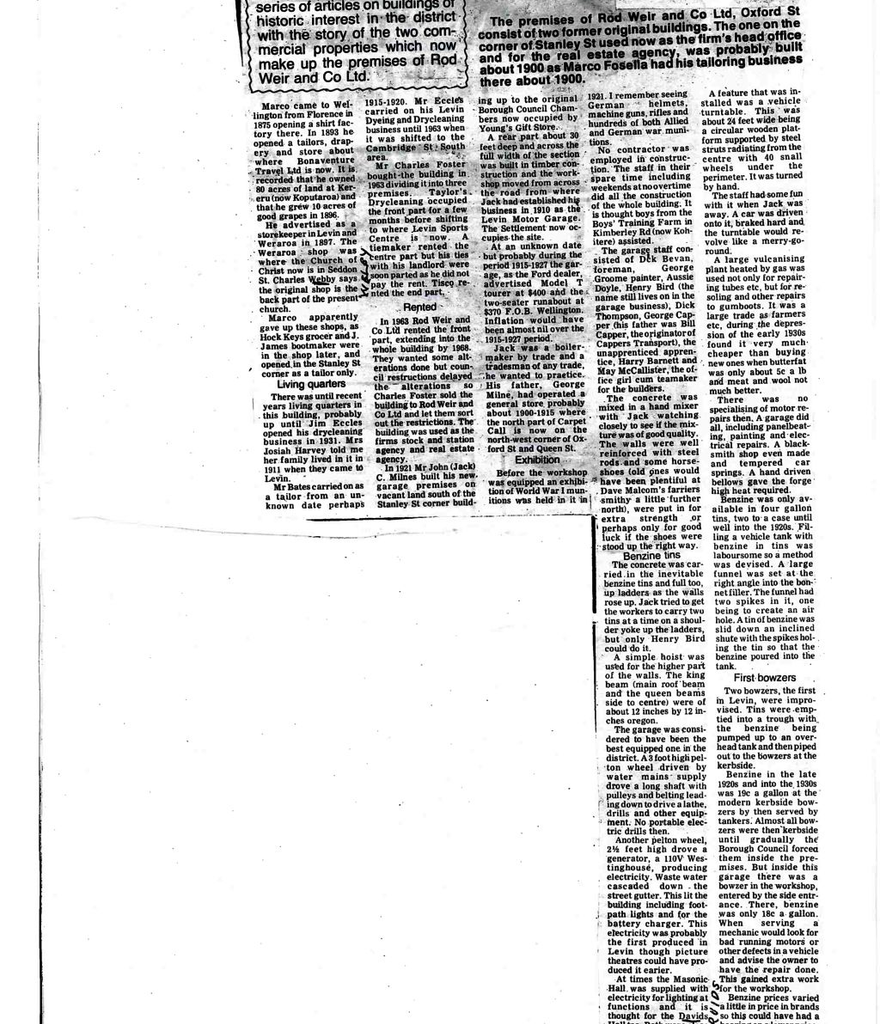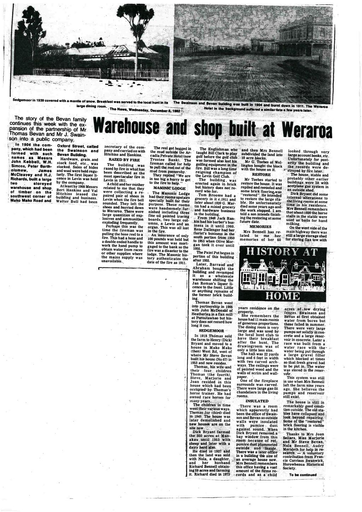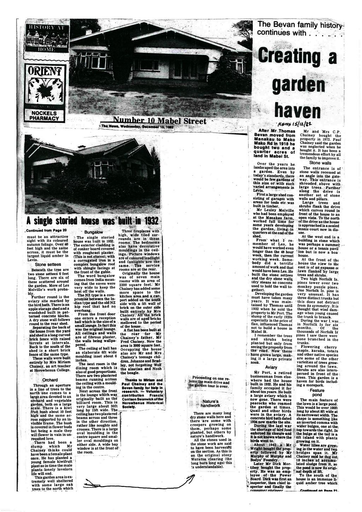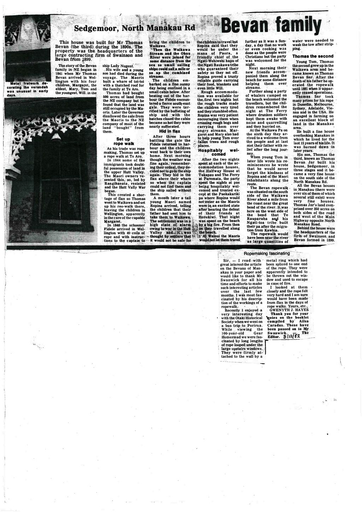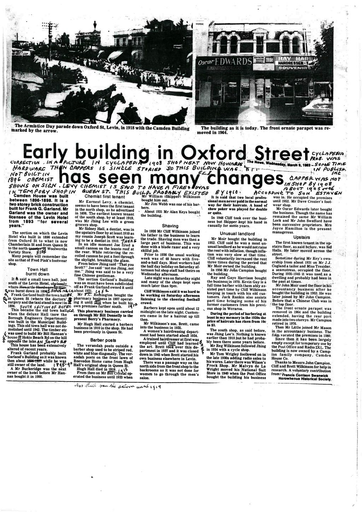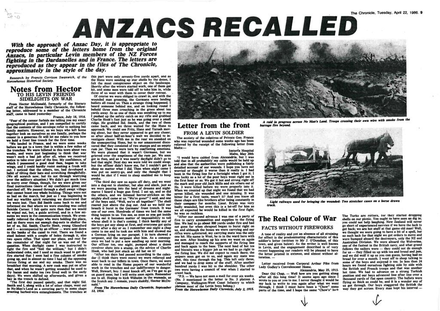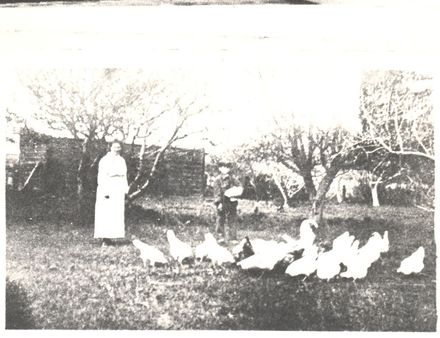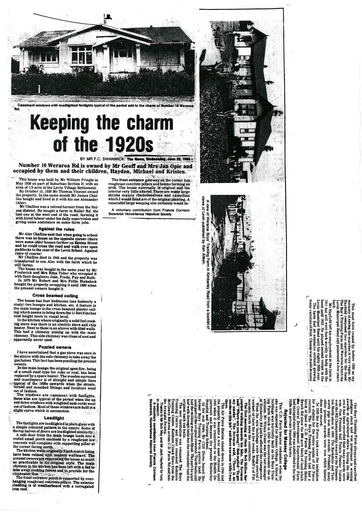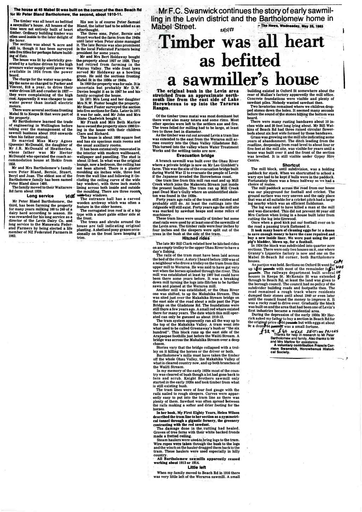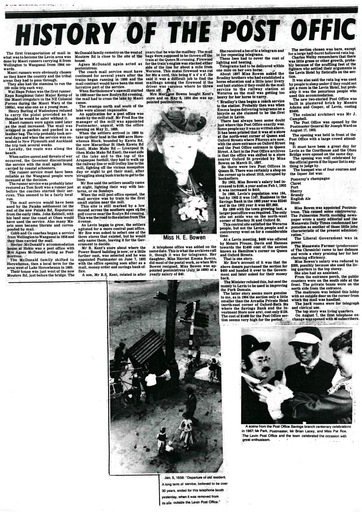History behind modern frontage
- Description
The premises of Rod Weir and Co. Ltd, Oxford St consist of two former original buildings. The one on the corner of Stanley St used now as the firm’s head office and for the real estate agency, was probably built about 1900 as Marco Fosella had his tailoring business there about 1900.
Marco came to Wellington from Florence in 1875 opening a shirt factory there. In 1893 he opened a tailors, drapery and store about where Bonaventure Travel Ltd is now. It is recorded that he owned 80 acres of land at Kereru (now Koputaroa) and that he grew 10 acres of good grapes in 1896.
He advertised as a storekeeper in Levin and Weraroa in 1897. The Weraroa shop was where the Church of Christ now is in Seddon St. Charles Welby says the original shop is the back part of the present church.
Marco apparently gave up these shops, as Hock Keys grocer and J. James bootmaker were in the shop later, and opened in the Stanley St corner as a tailor only.
Living Quarters
There was until recent years living quarters in this building, probably up until Jim Eccles opened his drycleaning business in 1931. Mrs Josiah Harvey told me her family lived in it in 1911 when they came to Levin.
Mr Bates carried on as a tailor from an unknown date perhaps 1915-1920. Mr Eccles carried on his Levin Dyeing and Drycleaning business until 1963 when it was shifted to the Cambridge St South area.
Mr Charles Foster bought the building in 1963 dividing it into three premises. Taylor’s Drycleaning occupied the front part for a few months before shifting to where Levin Sports Centre is now. A tiemaker rented the centre part but his ties with his landlord were soon parted, as he did not pay the rent. Tisco rented the end part.
Rented
In 1963 Rod Weir and Co Ltd rented the front part, extending into the whole building by 1968. They wanted some alterations done but Council restrictions delayed the alterations so Charles Foster sold the building to Rod Weir and Co. Ltd and let them sort out the restrictions. The building was used as the firm's stock and station agency and real estate agency.
 In 1921 Mr John (Jack) C. Milnes built his new garage premises on vacant land south of the Stanley St corner building up to the original Borough Council Chambers now occupied by Young’s Gift Store.
In 1921 Mr John (Jack) C. Milnes built his new garage premises on vacant land south of the Stanley St corner building up to the original Borough Council Chambers now occupied by Young’s Gift Store. A rear part about 30 feet deep and across the full width of the section was built in timber construction and the workshop moved from across the road from where Jack had established his business in 1910 as the Levin Motor Garage. The Settlement now occupies the site.
At an unknown date but probably during the period 1915-1927 the garage, as the Ford dealer, advertised Model T tourer at $400 and the two seater runabout at $370 F.O.B. Wellington. Inflation would have been almost nil over the 1915-1927 period.
Jack was a boilermaker by trade and a tradesman of any trade, he wanted to practice. His father, George Milne, had operated a general store probably about 1900-1915 where the north part of Carpet Call is now on the north-west corner of Oxford Street and Queen St.
Exhibition
Before the workshop was equipped, an exhibition of World Ward I munitions was held in it in 1921. I remember seeing German helmets, machine guns, rifles and hundreds of both Allied and German war munitions.
No contractor was employed in construction. The staff in their spare time including weekends at no overtime did all the construction of the whole building. It is thought boys from the Boys’ Training Farm in Kimberley (now Kohitere) assisted.
The garage staff consisted of Dick Bevan, foreman, George Groome, painter, Aussie Doyle, Henry Bird (the name still lives on in the garage business), Dick Thompson, George Capper (his father was Bill Capper, the originator of Cappers Transport), the unapprenticed apprentice Harry Barnett and May McCallister, the office-girl cum- teamaker for the builders.
The concrete was mixed in a hand mixer with Jack watching closely to see if the mixture was of good quality. The walls were well reinforced with steel rods and some horseshoes (old ones would have been plentiful at Dave Malcolm’s farriers smithy a little further north) were put in for extra strength or perhaps only for good luck if the shoes were stood up the right way.
Benzine tins
The concrete was carried in the inevitable benzine tins and full too, up ladders as the walls rose up. Jack tried to get the workers to carry two tins at a time on a shoulder yoke up the ladders, but only Henry Bird could do it.
A simple hoist was used for the higher part of the walls. The king beam (main roof beam and the queen beams side to centre) were of about 12 inches by 12 inches Oregon.
The garage was considered to have been the best equipped one in the district. A 3 foot high Pelton wheel driven by water mains supply drove a long shaft with pulleys and belting leading down to drive a lathe, drills and other equipment. No portable electric drills then.
Another Pelton wheel, 2½ feet high drove a generator, a 110V Westinghouse, producing electricity. Wastewater cascaded down the street gutter. This lit the building including footpath lights and for the battery charger. This electricity was probably the first produced in Levin though picture theatres could have produced it earlier.
At times the Masonic Hall was supplied with electricity for lighting at functions and it is thought for Druids Hall too. Both were close behind the garage.
When Mangahao power was available in 1924 the Power Board insisted on this power being used which Jack [part missing].
A feature that was installed was a vehicle turntable. This was about 24 feet wide being a circular wooden platform supported by steel struts radiating from the centre with 40 small wheels under the perimeter. It was turned by hand.
The staff had some fun with it when Jack was away. A car was driven onto it, braked hard and the turntable would revolve like a merry-go-round.
A large vulcanising plant heated by gas was used not only for repairing tubes etc. but for resoling and other repairs to gumboots. It was a large trade as farmers etc. during the depression of the early 1930’s found it very much cheaper than buying new ones when butterfat was only about 5c a lb and meat and wool not much better.
There was no specialising of motor repairs then. A garage did all, including panel beating, painting and electrical repairs. A blacksmith shop even made and tempered car springs. A hand-driven bellows gave the forge high heat required.
Benzine was only available in four gallon tins, two to a case until well into the 1920s. Filling a vehicle tank with benzine in tins was laboursome so a method was devised. A large funnel was set at the right angle into the bonnet filler. The funnel had two spikes in it, one being to create an air hole. A tin of benzine was slid down an inclined shute with the spikes holing the tin so that the benzine poured into the tank.
First bowzers
Two bowzers, the first in Levin, were improvised. Tins were emptied into a trough with the benzine being pumped up to an overhead tank and then piped out to the bowzers at the kerbside.
Benzine in the late 1920s and into the 1930s was 19c a gallon at the modern kerbside bowzers by then served by tankers. Almost all bowzers were then kerbside until gradually the Borough Council forced them inside the premises. But inside this garage there was a bowzer in the workshop, entered by the side entrance. There, benzine was only 18c a gallon. When serving a mechanic would look for bad running motors or other defects in a vehicle and advise the owner to have the repair done. This gained extra work for the workshop.
Benzine prices varied a little in price in brands so this could have had a bearing on a lower price. In fact, benzine could be transported in drums as this bowzer was filled from Wellington by carrier cheaper than by tanker. Bulk benzine was transported by rail tankers to depots in Cambridge St and tankers were filled from there, creating double handling.
Brands then were Atlantic, Shell, Plume, Big Tree and Voco, all 83 octane. Later Russian petrol, Europa, became available. The Europa Co. an independent formed by motorists to try to decrease the price of benzine, did so for some years until the war forced pooling of the newly named petrol. In use the pooled petrol seemed the same as the brand names.
Mr (Jack) Butler built the first Levin made aeroplane in the workshop. It flew quite a distance at the beach. Jack built it from 1927-1932. The plane was under-powered with a Model A Ford engine. It crashed from a low altitude breaking the fuselage. This and bureaurocratic controls ensured that the plane never flew again.
About 1933 the long king of beam of the garage was sagging. Allan Tindale had the job of jacking it up, fixing thick boards on the sides, boring holes through the 15 foot timber, with a hand drill and fixing bolts through the strengthened beam up a high ladder. He was only a young apprentice.
Jack Milnes had the Ford agency from 1910, but it was transferred to Levin Motors run by the Faloon brothers in the late 1930s where Kenden Motors Ltd are now. He then obtained the Morris agency.
In 1938 Wright Stephenson Ltd bought the business and leased the building having the Chevrolet, Holden and Vauxhall agencies.
During this period it was decided to remove the turntable as it had deteriorated. The workshop staff were asked to return at 6.30 pm one night to lift it out.
However, the staff on a higher level had it lifted out before then and gained $80 in small change which had rolled under it over the years. Allan Tindale vouches for this.
When Wright Stephenson built their own garage complex further north in 1968, they relinquished the lease. Rod Weir and Co Ltd bought the garage from the Milnes estate in 1968, then converted it to suit the general merchandise section of their stock and station agency.
The corner building has been converted for general office use for the headquarters of the Company which has now expanded with ten branches in the lower North Island and for offices for the staff of the estate agency section.
A two-storied structure was built at the west end in 1975.
At some stage the original wooden lean-to at the rear of the garage building was removed as it had deteriorated and a concrete back wall dividing it from the front main building has been demolished. The original 30 foot deep lean-to workshop has been replaced with a concrete block addition of only 8 feet to comply with Council requirements for off-street parking and land for the lane.
In 1982 the frontage was renovated, giving a uniform appearance to the two buildings.
Many uses made of empty benzine tins
The use of tinned benzine must have carried on into the 1930s, as plenty of empty tins were available. Farmers bought cases of benzine for use at home. Also kerosene bought in cases and tins was used a lot in tractors.
Before signposting of roads was universal, a driver knew he was off the main by the plentitude of benzine cases and tins on the side of the roads.
The uses of these empty cases and tins were many and varied.
Harry Barnett built a benzine store at the garage in concrete and what did he use for boxing ……… case timber of course. The cases, about 24 inches by 12 inches by 16 inches, were made of planed timber, the ends being ¾ inch thick and the sides ½ inch. The full cases were imported, probably mostly from the USA.
A tier of cases with open tops on their sides made shelves or a cupboard, if they were doored or curtained, for baches or even in houses of needy families.
Armchairs were made of several cases and with some padding and upholstery, were comfortable. Storage of various materials was a use for them. Dismantled, the boards had many uses.
When I was in Norfolk Is during the war I used to go fishing with a local man. The 200 foot cliffs had loamy formation on a steep slope for the top half. This soft material had a few tussocks growing on it and was riddled with mutton bird burrows. A 120 ft rope was tied to a split piece of benzine case to enable us to get down to a ladder with half of the rungs missing and tied with rusty wire to the rock. This ladder was straight up and down and had been put in by the convicts in the early 1840s.
I was rather galley about descending, but when a 10 year old boy went down I overcame my fears. It was the flimsy rope anchor I did not like.
As for the empty tins, the uses were more varied.
As buckets their use was universal. A piece of wire served as a handle. The skim milk on farms was carried to the pigs and calves and on poultry farms food and water was carried to the fowls.
They were also used to hold the big catches of whitebait in the 1920s and earlier. They were used for concrete boxing for piles and not removed, cake tins either cut crosswise or lengthwise, coal scuttles and general storage in houses or sheds for solids or liquids. Soap was put in split tins to harden after being made in a copper. They were used as pots and even fruit in jars was preserved in them on stoves. Split, leaving one end uncut, folded back and strengthened with boards, they made a good dishwashing sink, one half providing drainage for the washed dishes. Clothes were boiled, rinsed and even dyed in them. But right open they were used as sheathing on the outside of sheds.
On my previous five acre property a shed sheathed on one side thus, probably done in the 1930s, was, though rusty, mainly intact eight years ago. Once a bach at Hokio was entirely sheathed in opened out tins.
At Scobie’s Nursery in the 1930s, hundreds of tins opened on one side leaving one end hinged were used to pack flowers in and millions of violets went to market thus. We wrapped the tins in brown paper.
Tin canning
The most bizarre use was for tin canning a newly married couple when they arrived home. Friends etc would march around the house hitting the tins with sticks until they were invited in for refreshments to stop the infernal racket.
Many a person washed themselves in cut open tins. Always for whatever use they were put to the sharp edges were turned over.
Beer was even made in them. The tinny taste was overcome by the thought of the 5c cost of a pint in a hotel.
44 Many uses made of empty benzine tins
The use of tinned benzine must have carried on into the 1930s as plenty of empty tins were available.
Farmers bought cases of benzine for use at home. Also kerosene bought in cases and tins was used a lot in tractors.
Before signposting of roads was universal, a driver knew he was off the main by the plentitude of benzine cases and tins on the side of the roads.
The uses of these empty cases and tins were many and varies.
Harry Barnett built a benzine store at the garage in concrete and what did he use for boxing ……… case timber of course. The cases, about 24 inches by 12 inches by 16 inches, were made of planed timber, the ends being ¾ inch thick and the sides ½ inch. The full cases were imported, probably mostly from the USA.
A tier of cases with open tops on their sides made shelves or a cupboard, if they were doored or curtained, for bachs or even in houses of needy families.
Armchairs were made of several cases and with some padding and upholstery were comfortable. Storage of various materials was a use for them.
Dismantled, the boards had many uses.
When I was in Norfolk Is during the war I used to go fishing with a local man. The 200 foot cliffs had loamy formation on a steep slope for the top half. This soft material had a few tussocks growing on it and was riddled with mutton bird burrows. A 120 ft rope was tied to a split piece of benzine case to enable us to get down to a ladder with half of the rungs missing and tied with rusty wire to the rock. This ladder was straight up and down and had been put in by the convicts in the early 1840s.
I was rather galley about descending but when a 10 year old boy went down I overcame my fears. It was the flimsy rope anchor I did not like.
As for the empty tins the uses were more varied.
As buckets their use was universal. A piece of wire served as a handle. The skim milk on farms was carried to the pigs and calves on farms and on poultry farms food and water was carried to the fowls.
They were also used to hold the big catches of whitebait in the 1920s and earlier.
They were used for concrete boxing for piles and not removed, cake tins either cut crosswise or lengthwise, coal scuttles and general storage in houses or sheds for solids or liquids. Soap was put in split tins to harden after being made in a copper.
They were used as pots and even fruit in jars was preserved in them on stoves. Split, leaving one end uncut, folded back and strengthened with boards, they made a good dishwashing sink, one half providing drainage for the washed dishes. Clothes were boiled, rinsed and even dyed in them. But right open they were used as sheathing on the outside of sheds.
On my previous five acre property a shed sheathed on once side thus, probably done in the 1930s, was, though rusty, mainly intact eight years ago. Once a bach at Hokio was entirely sheathed in opened out tins.
At Scobie’s Nursery in the 1930s, hundreds of tins opened on one side leaving one end hinged were used to pack flowers in and millions of violets went to market thus. We wrapped the tins in brown paper.
Tin canning
The most bizarre use was for tin canning a newly married couple when they arrived home. Friends etc would march around the house hitting the tins with sticks until they were invited in for refreshments to stop the infernal racket.
Many a person washed themselves in cut open tins. Always for whatever use they were put to the sharp edges were turned over.
Beer was even made in them - the tinny taste was overcome by the thought of the 5c cost of a pint in a hotel.
Identification
- Date
- January 26, 1983
Taxonomy
- Community Tags

